
Clam juice is a broth derived from steamed clams, [1] which can be consumed on its own or used as an ingredient in various dishes and beverages.

Clam juice is a broth derived from steamed clams, [1] which can be consumed on its own or used as an ingredient in various dishes and beverages.
Clam juice is typically prepared from the liquid obtained from steamed clams. [1] Clam juice may be prepared fresh for consumption, [2] or purchased in prepared bottled form. [1] [3] Some companies mass-produce prepared clam juice, which is made by steaming fresh clams in water with salt, collecting the extracted liquid known as clam extract or clam liquor, and then filtering it. [1] [4]
In 1937, William G. Frazier invented a clam opener devised to easily open clams and retain all of the clam juice, which was collected in a bowl. [5] A patent for the clam opener was issued by the United States Patent and Trademark Office on November 15, 1938. [5]
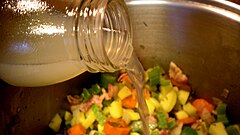
Clam juice is sometimes used in the preparation of clam chowder and other chowders. [3] It may be used as an ingredient in various sauces and meat sauces, seafood dishes, in soup bases, and as a condiment to top foods, similar to the manner that fish sauce may be used. [1] [6] [7]
Italian chefs sometimes use clam juice as an ingredient in seafood dishes and pasta sauces. [1] It is sometimes used during the deglazing process in cooking. [1] It may provide a mineral-like flavor to dishes, and serve as a substrate to assist in combining flavors present in a dish. [1]
Some restaurants and bars in the US serve shots of pure clam juice. [8] For example, the Old Clam House in San Francisco, California serves a shot glass of hot clam juice at the beginning of each meal. [8] In the early 1900s in the United States, clam juice was purported to be a hangover remedy. [1]

The Everleigh Club, a former brothel in Chicago, Illinois, that was in operation from 1900 to October 1911, would serve iced clam juice and a tablet of aspirin as a starter for breakfast, which began at 2:00 in the afternoon. [9] [10]
In the United States in the early 1900s, clam juice was used as an ingredient for various beverages at soda fountains. [11] Beverages prepared with clam juice included hot clam juice, hot clam soda, hot ginger clam broth, hot celery punch, hot clam cream, clam night cap, tomato clam broth and others. [11] [12] [13] [14]
During this time, a recipe for hot clam juice used one-half to one-ounce of clam juice in an eight-ounce glass, the remainder of which was filled with hot water. [11] Accompaniments included soda crackers, celery salt, salt and pepper. [11] The beverage was sometimes prepared with the addition of milk or hot milk. [11] The addition of a small portion of butter would enhance the flavor of hot clam juice. [11]
In contemporary times, clam juice is sometimes used as an ingredient or drink mixer in cocktails, such as the Caesar, [2] [15] [16] also known as a Bloody Caesar. [17]
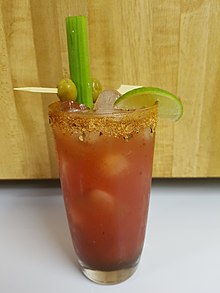
Clamato is a mass-produced beverage prepared with tomato juice concentrate, clam juice and spices. [18] [19] It also contains high fructose corn syrup, monosodium glutamate, salt and ascorbic acid. [19] Clamato is used as an ingredient in the Caesar cocktail. [20] The michelada, a beer cocktail, is sometimes prepared using Clamato as an ingredient. [21]

Chowder is a thick soup prepared with milk or cream, a roux, and seafood or vegetables. Oyster crackers or saltines may accompany chowders as a side item, and cracker pieces may be dropped atop the dish. Clam chowder from New England is typically made with chopped clams and diced potatoes, in a mixed cream and milk base, often with a small amount of butter. Other common chowders include seafood chowder, which often consists of fish, clams, and other types of shellfish; lamb or veal chowder made with barley; corn chowder, which uses corn instead of clams; various fish chowders; and potato chowder, which is often made with cheese. Fish, corn, and clam chowders are popular in North America, especially Atlantic Canada and New England.
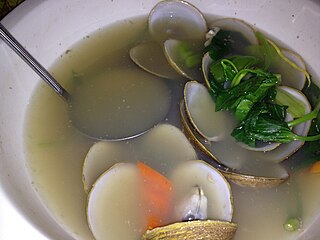
Clam soup is a soup prepared using clams as a primary ingredient. Clam soup can be prepared as a thin, broth- or cream/milk-based soup and as a thicker, chowder-style soup. In Japan, hot miso soup prepared with clams is believed by some to be a cure for the hangover.

Ceviche, cebiche, sebiche, or seviche is a dish consisting of fish or shellfish marinated in citrus and seasonings, and is recognized by UNESCO as an expression of Peruvian traditional cuisine and Intangible Cultural Heritage of Humanity. Different versions of ceviche are part of the culinary culture of various Spanish-American countries along the Pacific Ocean where each one is native: Chile, Colombia, Costa Rica, Ecuador, El Salvador, Guatemala, Honduras, Mexico, Nicaragua, Panama and Peru. In Peru it is also considered a flagship dish and cultural heritage.
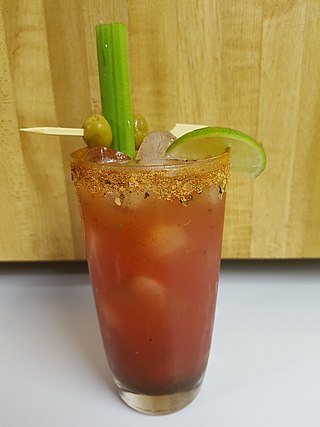
A Caesar is a cocktail created and consumed primarily in Canada. It typically contains vodka, Clamato, hot sauce, and Worcestershire sauce, and is served with ice in a large, celery salt-rimmed glass, typically garnished with a stalk of celery and wedge of lime. What distinguishes it from a Bloody Mary is the inclusion of clam broth. The cocktail may also be contrasted with the Michelada, which has similar flavouring ingredients but uses beer instead of vodka. Festivals dedicated to the cocktail are held in many cities, with the largest in Calgary. The first liquor store dedicated to the Caesar opened on July 1, 2023 in Calgary, Alberta.
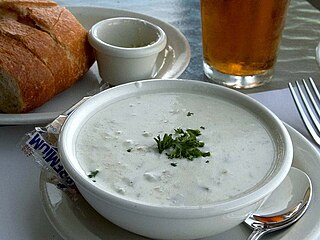
Clam chowder is any of several chowder soups in American cuisine containing clams. In addition to clams, common ingredients include diced potatoes, salt pork, and onions. Other vegetables are not typically used. It is believed that clams were used in chowder because of the relative ease of harvesting them. Clam chowder is usually served with saltine crackers or small, hexagonal oyster crackers.

Tomato juice is a juice made from tomatoes, usually used as a beverage, either plain or in cocktails such as a Bloody Mary, a Caesar, or Michelada.

Clamato, , is a commercial drink made of reconstituted tomato juice concentrate and sugar, which is flavored with spices, dried clam broth and MSG. It is made by Mott's. The name is a portmanteau of clam and tomato. It is also referred to colloquially as "clamato juice". It is consumed in Canada, Mexico, and the United States, to a lesser extent. It is very often mixed with alcohol to make a Caesar, a drink similar to a Bloody Mary.

Salvadoran cuisine is a style of cooking derived from the nation of El Salvador. The indigenous foods consist of a mix of Amerindian cuisine from groups such as the Lenca, Pipil, Maya Poqomam, Maya Chʼortiʼ, Alaguilac and Cacaopera peoples and some African influences. Many of the dishes are made with maize (corn). There is also heavy use of pork and seafood. European ingredients were incorporated after the Spanish conquest.

A raw bar is a small restaurant or a bar within a restaurant where live shellfish are shucked and served. Raw bars typically offer a variety of raw and cooked seafood and shellfish that is served cold. Seafood-based dishes may also be offered, and additional, non-seafood foods may also be part of the fare. Raw bars may offer alcoholic beverages such as oyster shooters, as well as wine and sake that is paired with various foods. Additional accompaniments may include condiments, sauces and foods such as lemon and lime. Several restaurants in the United States offer raw bars, some of which are seasonal.
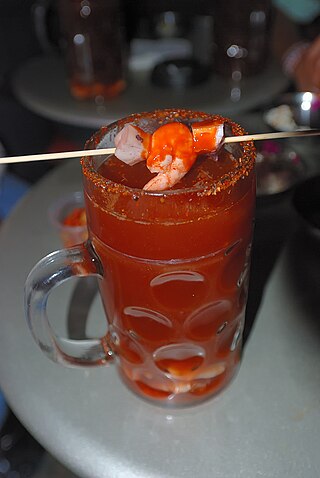
A michelada is a Mexican drink made with beer, lime juice, assorted sauces, spices, and chili peppers. It is served in a chilled, salt-rimmed glass. There are numerous variations of this beverage throughout Mexico.

Colombian cuisine is a culinary tradition of the six main regions within Colombia. Colombian cuisine varies regionally and is influenced by Indigenous Colombian, Spanish, and African cuisines, with a slight Arab influence in some regions.
Drink mixers are the non-alcoholic ingredients in mixed drinks and cocktails. Mixers dilute the drink, lowering the alcohol by volume in the drink. They change, enhance, or add new flavors to a drink. They may make the drink sweeter, more sour, or more savory. Some mixers change the texture or consistency of the drink, making it thicker or more watery. Drink mixers may also be used strictly for decorative purposes by changing the color or appearance of the drink. They also simply increase the volume of a drink, to make it last longer.

Fish soup is a food made by combining fish or seafood with vegetables and stock, juice, water, or another liquid. Hot soups are additionally characterized by boiling solid ingredients in liquids in a pot until the flavors are extracted, forming a broth.

A Bloody Mary is a cocktail containing vodka, tomato juice, and other spices and flavorings including Worcestershire sauce, hot sauces, garlic, herbs, horseradish, celery, olives, pickled vegetables, salt, black pepper, lemon juice, lime juice and celery salt. Some versions of the drink, such as the "surf 'n turf" Bloody Mary, include shrimp and bacon as garnishes. In the United States, it is usually consumed in the morning or early afternoon, and is popular as a hangover cure.

Cadbury Schweppes Inc v FBI Foods Ltd is a Supreme Court of Canada decision on the protection of trade secrets in Canada. It also describes the difference between trade secrets and patents under Canadian law.

North Korean cuisine is the traditional culinary practices and dishes of North Korea. Its foundations are laid by the agricultural and nomadic traditions in southern Manchuria and the Korean Peninsula. Some dishes are shared by the two Koreas; however, availability and quality of Northern cuisine is much more significantly affected by sociopolitical class divides.
Clam juice may be tried in the vomiting of pregnancy (Thompson).p. 586.